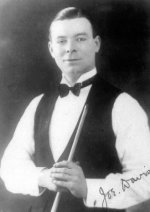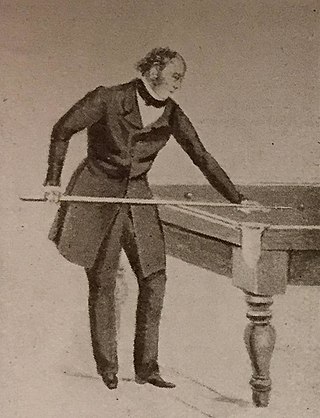
English billiards, called simply billiards in the United Kingdom and in many former British colonies, is a cue sport that combines the aspects of carom billiards and pool. Two cue balls and a red object ball are used. Each player or team uses a different cue ball. It is played on a billiards table with the same dimensions as one used for snooker and points are scored for cannons and pocketing the balls.

Joseph Davis was an English professional snooker and English billiards player. He was the dominant figure in snooker from the 1920s to the 1950s, and has been credited with inventing aspects of the way the game is now played, such as break-building. With the help of equipment manufacturer Bill Camkin, he drove the creation of the World Snooker Championship by persuading the Billiards Association and Control Council to recognise an official professional snooker championship in 1927. Davis won the first 15 world championships from 1927 to 1946, and he is the only undefeated player in World Snooker Championship history. In 1935, he scored the championship's first century break.

Herbert John Pulman was an English professional snooker player who was the World Snooker Champion from 1957 to 1968. He first won the title at the 1957 Championship and retained it across seven challenges from 1964 to 1968, three of them against Fred Davis and two against Rex Williams. When the tournament reverted to a knockout event in 1969, he lost 18–25 in the first round to the eventual champion John Spencer. After finishing as runner-up to Ray Reardon in 1970, Pulman never again reached the final, although he was a losing semi-finalist in 1977.
Desmond Rex Williams is an English retired professional billiards and snooker player. He was the second player to make an official maximum break in snooker, achieving this in an exhibition match in December 1965. Williams won the World Professional Billiards Championship from Clark McConachy in 1968, the first time that the title had been contested since 1951. Williams retained the title in several challenge matches in the 1970s and, after losing it to Fred Davis in 1980, regained it from 1982 to 1983.

Willie Smith was an English professional player of snooker and English billiards. Smith was, according to an article on the English Amateur Billiards Association's website, "by common consent, the greatest all-round billiards player who ever lived".
The 1927 World Snooker Championship was a snooker tournament held at several venues from 29 November 1926 to 12 May 1927. At the time, it was titled the Professional Championship of Snooker but it is now recognised as the inaugural edition of the World Snooker Championship. The impetus for the championship came from professional English billiards player Joe Davis and billiard hall manager Bill Camkin, who had both observed the growing popularity of snooker, and proposed the event to the Billiards Association and Control Council. Ten players entered the competition, including most of the leading English billiards players. The two matches in the preliminary round were held at Thurston's Hall in London, and the semi-finals and final took place at Camkin's Hall in Birmingham. The players involved determined the venues for the quarter-finals, resulting in matches in London, Birmingham, Nottingham and Liverpool.
Clive Harold Everton was an English-born Welsh sports commentator, journalist, author and professional snooker and English billiards player. He founded Snooker Scene magazine, which was first published in 1971, and continued as editor until September 2022. He authored over twenty books about cue sports from 1972 onwards.

John Joseph Rea was a Northern Irish snooker player. He was the leading Irish snooker player until the emergence of Alex Higgins and held the Irish Professional Championship almost continuously from 1952 to 1972.

Tom Reece was an English professional player of English billiards. He was six times runner-up in the professional billiards championship, now regarded as the world championship, losing three times to Melbourne Inman in finals from 1912 to 1914, and three times to Tom Newman in the 1921, 1924 and 1925 finals. He made the unofficial world's highest billiards break of 499,135 in 1907 using a cradle cannon technique shortly before it was banned from the sport. In 1927, his prowess with the pendulum stroke led to that also being banned from use in competition.
The World Billiards Championship is an international cue sports tournament in the discipline of English billiards, organised by World Billiards, a subsidiary of the World Professional Billiards and Snooker Association (WPBSA). In its various forms, and usually as a single competition, the title is one of the oldest sporting world championships, having been contested since 1870.

John Roberts Jr was a dominant English professional player of English billiards. He won the world professional title eight times in matches between 1870 - 1885 when it was held on a challenge basis. His highest break came in 1894. Roberts was also a notable manufacturer of billiards cues and tables, and promoter of the sport.
Jack Karnehm was a British snooker commentator, who was regularly heard on BBC television from 1978 until 1994, and a former amateur world champion at the game of English billiards. Karnehm was also a professional snooker and billiards player.
The 1935 World Snooker Championship was a snooker tournament held at Thurston's Hall in London, England from 8 to 27 April 1935. It was the first edition of the Championship to incorporate "world" in its name, being called the World's Professional Snooker Championship. Joe Davis won the title for the ninth time by defeating Willie Smith by 28 frames to 21 in the final, having achieved a winning margin at 25–20. Davis recorded the first century break in the history of the championship, a 110 in his semi-final match against Tom Newman.
The World Professional Match-play Championship was a professional snooker tournament established in 1952 as an alternative to the professional World Snooker Championship by some of the professional players, following a dispute with the Billiards Association and Control Council, the sport's governing body. Fred Davis won the first five editions of the tournament, but didn't participate in 1957, when John Pulman won. After this, the event was discontinued due to a decline in the popularity of snooker.
The Billiards and Snooker Control Council (B&SCC) was the governing body of the games of English billiards and snooker and organised professional and amateur championships in both sports. It was formed in 1919 by the union of the Billiards Association and the Billiards Control Club.

Charles Raynor Dawson was an English champion player of English billiards. He held the world professional title in billiards in 1899, 1900, 1901 and 1903, when it was held on a challenge basis.
John Roberts Sr was a Welsh champion player of English billiards.

Edwin Kentfield also known as Jonathan Kentfield, was an English player of English billiards. He claimed the Billiards Championship in 1825 and held it uncontested until 1849.

Claude Falkiner was an English player of English billiards. He was runner-up in the professional championship in 1920 and 1922. He also entered the 1939 World Snooker Championship.

Charles Chambers was a referee for the cue sports of snooker and English billiards. He worked at Thurston's Hall in London for three decades and was as well known in billiards circles as the leading players. He was the referee during Walter Lindrum's world record billiards break of 4,137 points in 1932. Chambers was the first referee to receive an "A class" certificate from the Billiards Association and Control Council, and refereed the final of the 1937 World Snooker Championship between Joe Davis and Horace Lindrum. His ruling in a 1938 match led to a minimum length cue being specified in the official rules of the game.











